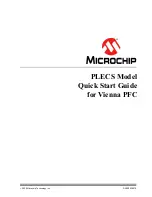
Chapter 7. PID Built-In Function Block
360
PACSystems* RX7i, RX3i and RSTi-EP CPU Programmer's Reference Manual
GFK-2950C
7.6
Setting Tuning Loop Gains
7.6.1
Basic Iterative Tuning Approach
Because PID parameters are dependent on the process being controlled, there are no predetermined
values that will work. However, a simple iterative process can be used to find acceptable values for
Kp, Ki, and Kd gains.
1.
Set all the reference array parameters to 0, then set the CV Upper and CV Lower Clamps to the
highest and lowest CV expected. Set the Sample Period to a value within the range T
c
/10 to
T
c
/100, where T
c
is the estimated process time constant defined in
2.
Put the PID function block in Manual mode and set the Manual Command (word 14 in the
reference array) to different values to check if CV can be moved to Upper and Lower Clamp.
Record the PV value at some CV point and load it into SP.
3.
Set a small gain, such as 100 * Maximum CV/Maximum PV, into Kp and turn off Manual mode.
Step SP by 2% to 10% of the Maximum PV range and observe PV response. Increase Kp if PV step
response is too slow or reduce Kp if PV overshoots and oscillates without reaching a steady
value.
4.
Once a Kp is found, start increasing Ki to get overshooting that dampens out to a steady value in
two to three cycles. This may require reducing Kp. Also try different SP step sizes and CV
operating points.
5.
After suitable Kp and Ki gains are found, try adding Kd to get quicker responses to input changes,
providing it doesn't cause oscillations. Kd is often not needed and will not work with noisy PV.
6.
Check gains over different SP operating points and add Dead Band and Minimum Slew Time if
needed. Some Reverse Acting processes may need setting of Config Word Error Term or Output
Polarity bits.
Summary of Contents for PACSystems RX7i
Page 357: ......
Page 466: ...Chapter 9 Diagnostics GFK 2950C February 2018 451...
















































